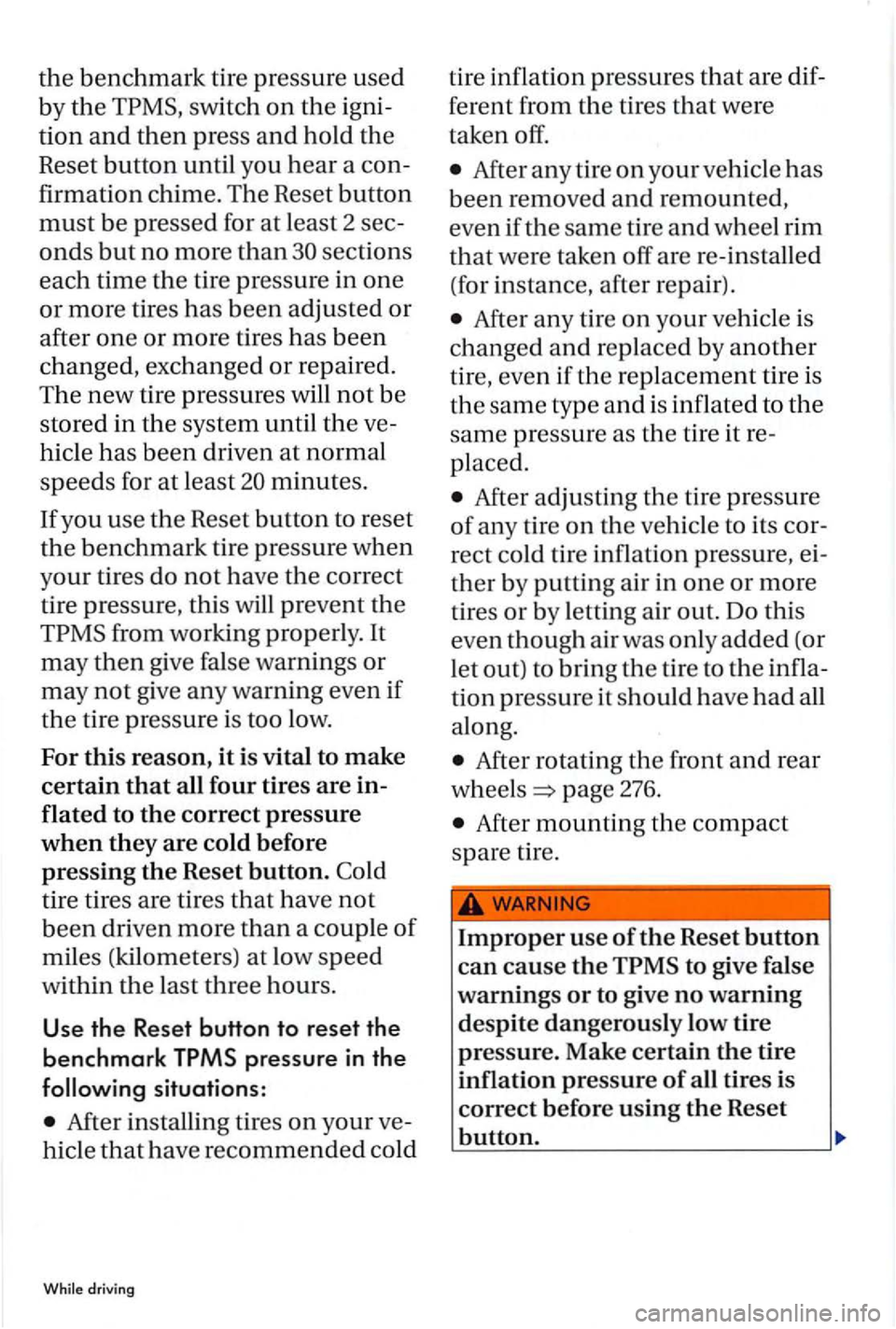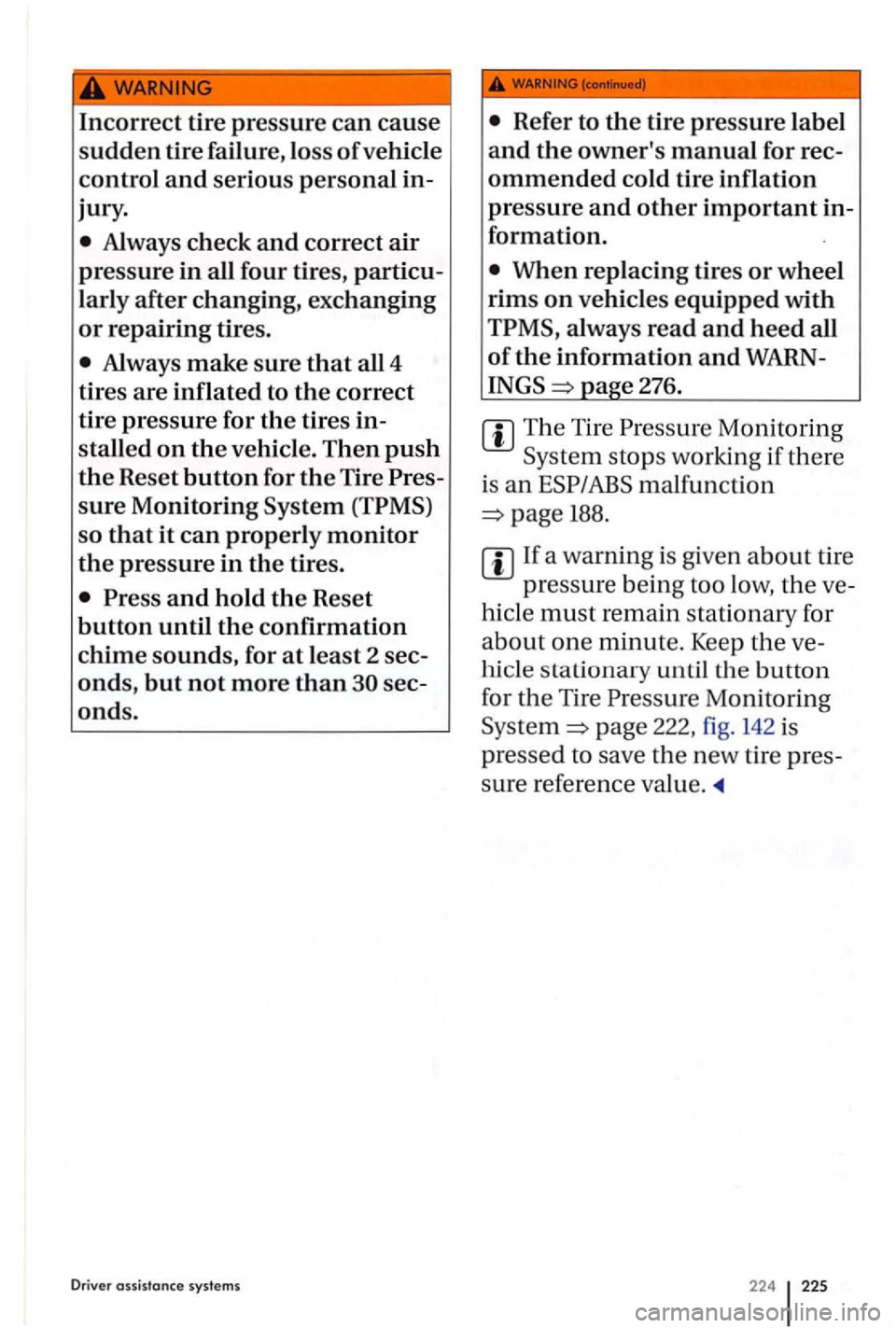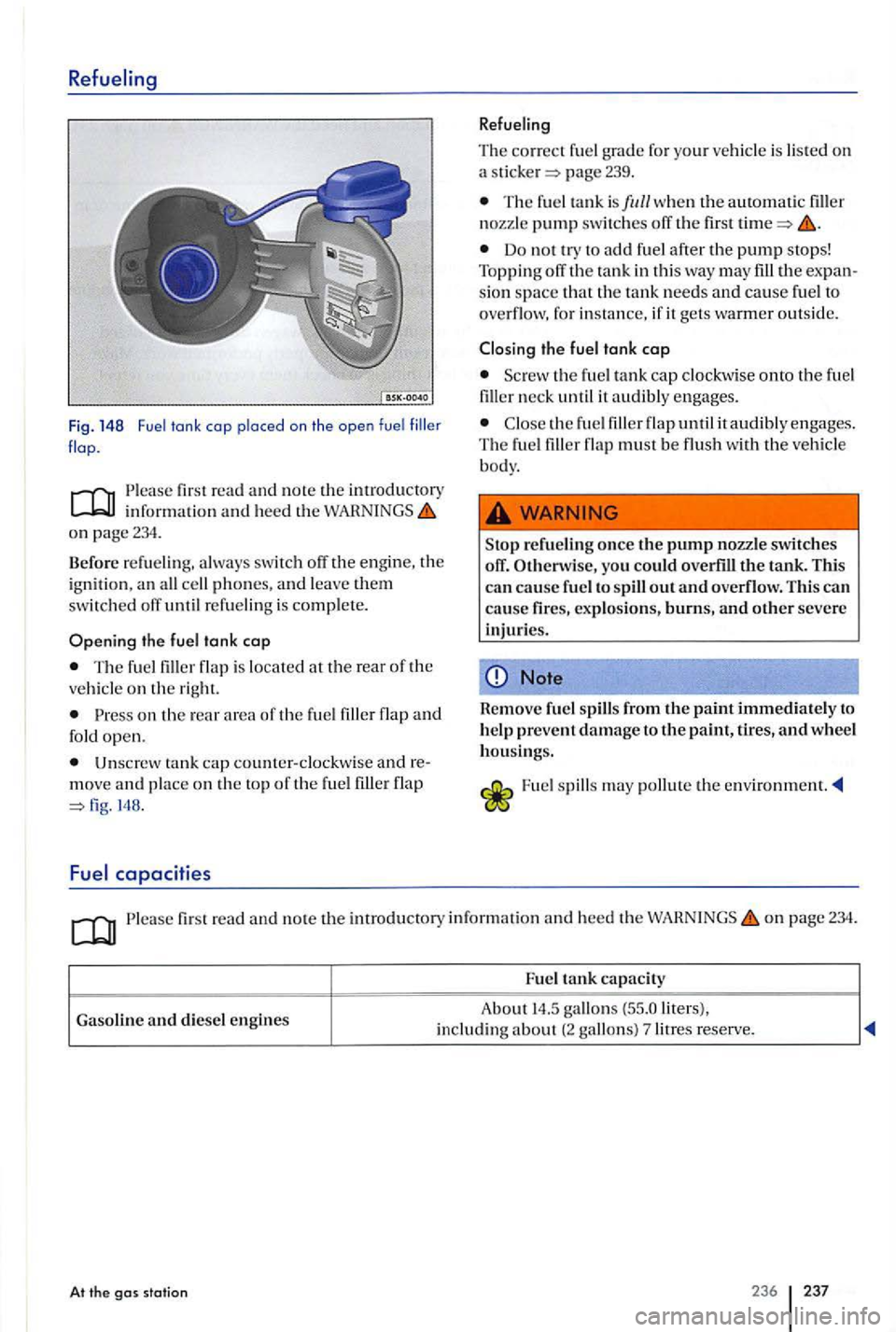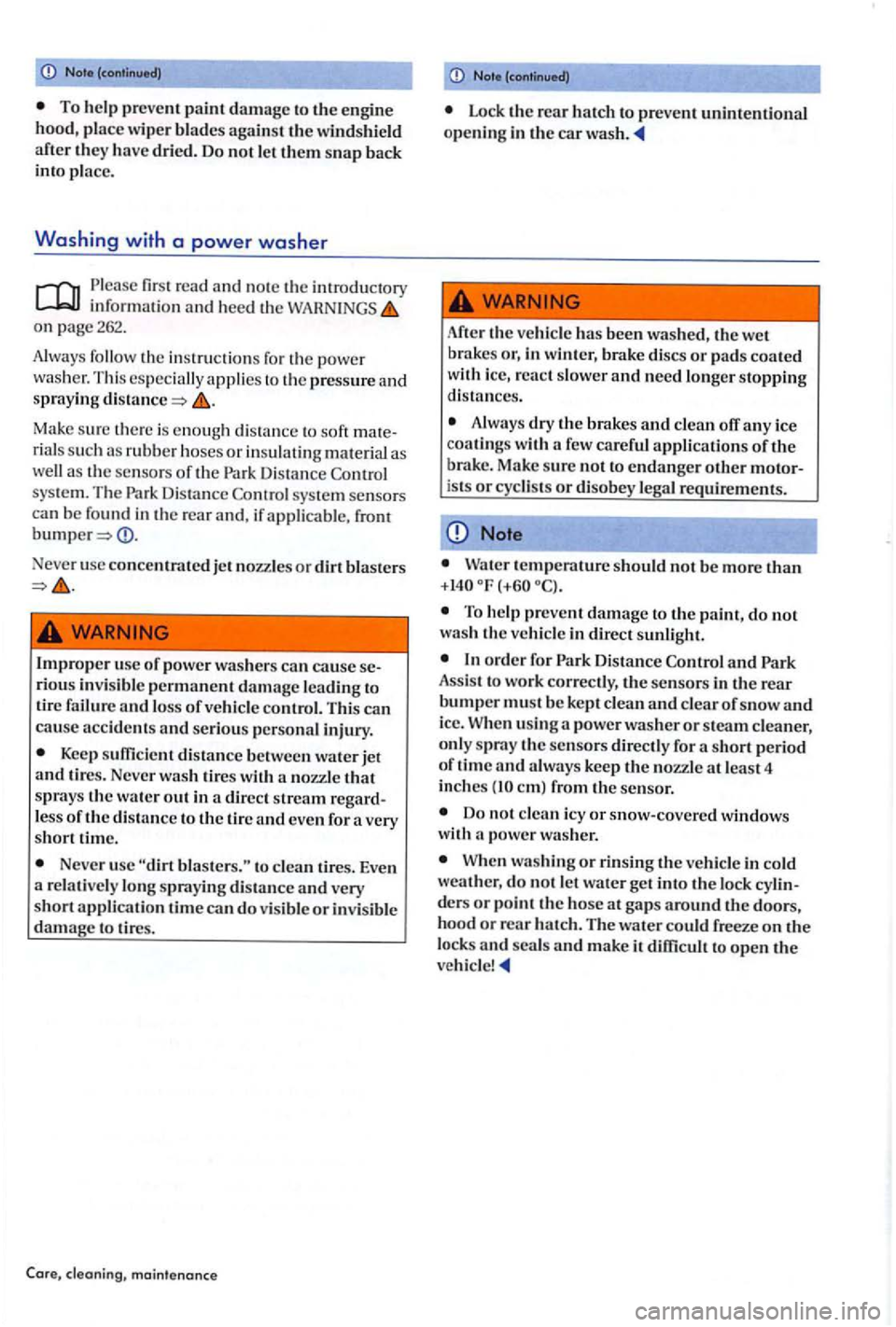2006 VOLKSWAGEN GOLF PLUS tires
[x] Cancel search: tiresPage 218 of 541

Function and operation
Fig. 141 In the cen te r co nsole : b uHon fo r Dynomic C hoss is
Please read and note th e introductory inf ormati on and hee d t he on page 218.
D ynamic C hassis Control lets you prese lec t
chassi s dam ping for comfo rt or sporty driving .
pro grams.
T he
program also affec ts th e feel of the steering .
Driver assis tanc e systems
Program R
ecommended driving
Comfort- oriented setting, for driving on poor roa ds and driving lon g di sta nces .
Balanced
setting, for everyday
u se.
a program
o n th e ignition.
re p ea te dl y th e des ired progra m is
disp laye d.
Th e
nor illumin ated in the button. Turning off the
i g nition does no t chan ge the program you have lec ted.
Driv ing characteristics can
change after choosing chassis suspension setting. Drive just as carefully as you would if the vehicle did not
h ave Neve r let it tempt you into takin g
risks.
Always adapt your speed and driving style to
visibil and traffic condit ions.
malfunctions , flash in the button. Driving comfo rt might be affec te d b y th e malfunction. Tak e th e ve hicl e to an authorized Volk swage n
d ea ler or an authorize d Volkswa gen
218 219
Please read and note the introdu ctory information and h eed the WARNINGS on page
Poss ible cause or
Lights up and a chime sounds: Tire pressure is too in one o r more tires compa re d wi th th e ben chmark press ure
se t by the driver-or ti re has stru ctural
damage. A co rre spo ndi ng warning
sa ge may also app ear in the instrument cluster.
Fla s hes for abo ut seconds and then stay s on: malfun ction.
W h
en the ignition i s s witched on, severa l warning
a nd ind icato r light s come on briefly fo r funct ion
c h ec k. Th ey go out after a few seco nds.
Incorrec t lire pressures and/or under- inflati on can cause sudden tire failure , loss of control , lisio n, seriou s personal injury, o r even death.
When the warning symb ol
In correc t tir e pressure a nd/or tio n can ca use incre a se d tir e wear and ca n affe ct the handling of th e ve hicle and its stoppin g
Incor rec t tir e pressure and/or ti o n can also lead t o sudden tir e fa ilu re,
Proper response
Heduc e speed imm ediately! Always
s t
op th e vehicle as soon as it is safe do so . Avoid fas t cornerin g and hard braking!
tion press ure in all four tires. If th e tir e
cilit y c heck the sys tem.
(continued)
Always inflate tires to the correct tire re befor e drivin g off .
Driv in g with under-inflat ed tire s causes them to flex more, letting the m get too hot,
which can
Excessive speed and/or over loading can
ca use heat build -up, sudden tire failure , and lo ss of control.
If the tire pressure is too low or too high , th e tires wear prematurely and the vehicl e will
not handl e we ll.
If the tire is not and yo u d o no t h ave
t o ch an ge the tire or whee l immediat ely , drive a t
reduced spee d to the nearest serv ice station to
c h eck th e tir e pressure and add
Page 219 of 541

Tire Pressure Monitoring System (TPMS)
this section you'll find informati on on th e lowing:
. . . . . . . . . . . . . . . . . . . . . . . . . . . . . . . . . . . . . 221
Monitor ing System
Monito ring Sys te m indirectly c hecks the tire pressure of all
f our tires while you are driving by us ing the lock Brake Syste m (ABS) sensor s to monitor the
tr ea d circumf erenc e and vibration ch arac te ris tics of the indi vidua l tir es. warns if there is a nifi cant loss of pres sure in one or more tires while
the vehicl e is mo vin g. loss is s ig nale d b y
the ind icato r light as by an aco usti c
wa rni ng and text warnin gs in the in strument clu ster di spla y if your ve hicle has an MFD. The
origina l b en chmark pre ssure is th e recommended
m axi mum load cold tire inflati on pressure for the tire s that come with your vehicle that is lis te d on
th e tire pressure lab el on the dri ver door pill ar. By press ing the Reset button , yo u can ch ange the
b enchmark pressure to match th e c urr ent pressure of the tir es on you r page 222.
use of the Heset butto n i s explained below 222.
More informa tion:
page 137
Bra king, stopping and page 188
Ext e rior care an d page 262
page 276
pa ge303
Whil e driving
An acoustic warni ng sounds th e first time low tire pressure is detec ted. a system
Improp er tire care can cause sudden tire sure loss,
hicle control, accidents, and serious personal
injury .
tire inflation pressure regularl y when the tires are cold and alway s maintain the scribed tire pressure . Low tire pressure can cause tires to get too hot, res ultin g in tread ration, sudden lo ss of pres sure, and blowout s.
Thi s is because tires with excessively low
sure undergo more flexi ng, which can cau se the tir e to overheat and destroy the tire.
Always maintain correct cold tire inflation pressure as listed on the tire pressure label
Check tire inflation pressure regularl y when the tires are cold. Adjust tir e press ure in the cold
tir e to the recommended tire pressure for t11e tires installed on your vehicl e as necessary.
Neve r exceed the permissi ble maximum speed and load rating of the tires on your hicl e.
Imprope r us e of the Reset button can cause the to give false warnings or to give no
warning des pite dangerou sly lo w tire pressure
page222.
Und er- inflat ion increases fue l con sumptio n and tire wear.
to ring Syste m.
bedde d in the tir e tre ad but have n o t penetrated
int o the body of tire
Driving on u npaved roads for an extended
The te lltal e
s h ows a malfunc tion but switch es orr if road dit io ns or th e drivin g sty le c han ges or if th e tio n is switch ed on and orr
Tire Pressure Monitoring System (TPMS) and reset button
the center or in
the compartment: Button for th e
T
ire Pressure Monitoring System.
first r ead and note the
introductory informatio n
and heed the WARNINGS on
page
ve hicle's Tir e Moni
torin g
indirectly
c h ec ks
the ti re pressure of al l four
tire s while yo u are drivin g by us
ing
the Anti -loc k
If there is more weight on one
axle than the other (such as when
towin g a trailer) .
Page 220 of 541

Each tire, including the spare (if
provided),
should be checked
monthly w hen cold and inflated to
the inflation pressure recom
mended by the vehicle manufac
turer
on the vehicle placard or tire
inflation pressure label.
(If your
vehicle
has tires of a different size
than the size indicated on the ve
hicle placard
or tire inflation pres
sure label, you sho uld determine
the proper tire inflation pressure
for
those tires.)
As an added safety feature, your
vehicle
has been equipped with a
Tire
is not a
substitute for proper tire mainte
nance,
and it is the driver's re
sponsib ility to
maintain correct
tire pressure , even if under-infla
tion
has not reached the level to
trigger illumination
of the
low tire pressure telltale.
Driver assistance systems
Your vehicle has also been
equipped with a malfunc
tion indicator to indicate
when the
system is not operating properly.
The
malfunction indicator is
combined with the low tire pres
sure telltale. When
the system de
tects a malfunction, the telltale
will flash for approximate ly
one
minute and then remain continu
ously illuminated. This sequence
will continue upon subsequent ve
hicle
start-ups as long as the mal
function exists.
When
the malfunction indicator is
illuminated, th e system may not
be able to detect or signal low tire
pressure
as intended.
to continue
to function properly.
Re-setting and reconfirming the
benchmark tire pressure for TPMS
The Reset button for the Tire
sure Monitoring is in the
glove compartment=> page 222,
fig. 142. The Reset button resets the
benchmark tire pressure used by
the
to the current tire pres
sure
in the tires based on the cir
cumference
of the tires. To reset
222 223
Page 221 of 541

the benchmark tire pressure used
b y
the swi tch on the igni
tion
and then press and hold the
Reset button until you hear a con
firmation chime. The Reset button
must be pressed for at least 2 sec
onds but no more than sect ions
each time
the tire pressure in one
or more tire s has bee n adjusted or
after
one or more tires has been
changed, exchanged or r
epaired.
The new tire pressures will not be
st
ore d in the system until the ve
hicle has b
een driven at normal
s p eeds for
at leas t minutes.
If you use the Reset button to reset
the ben chmark tire pressure when
yo
ur tires do not have the corre ct
t ir e pressure, this
will prevent the
After installin g tires on your ve
hicle
that h ave recom mended co ld
driving
tire infl ation pressures that are dif
ferent from the tires that were
taken off.
After any tire on you r ve hicl e has
b
een removed and remounted,
even if t he sa me tire
and w hee l rim
that were taken off are re-insta ll ed
(for instance, after repair).
After a ny tire on you r veh icle is
changed
and r ep lace d by another
tire, even if th e rep lace me
nt tire is
th e
same type and is inflated to the
same press ure as the tir e it re
pl ace d.
After adjusting the tire pressure
of an y tire on the ve hicl e
to its cor
rect cold tire in flation pressure, ei
ther by putting air in one or more
tires
or by let tin g air out. Do this
even though air was o
nly added (or
let out)
to bring the tir e to the infl a
tion pressure it should have had all
along .
After rotating the front and rear
w he els
page 276.
After mounting th e compact
s pare tir
e.
Improper use of the Reset button
can cause the to give false
warnings
or to give no warning
d espite dangerously low tire
pressure. Make certain
the tire
inflation pressure
of all tires is
correct before using
the Reset
button.
Page 222 of 541

Incorrect tire pressure can cause
sudden tire failure, loss of vehicle
control and serious personal in
jury.
Always make sure that all 4
tires
are inflated to the correct
tire pressure for the tires in
stalled on the vehicle. Then push
the Reset button for the Tire
sure Monitoring System
so that it can properly monitor
the pressure in the tires.
always read and heed all
of the information and WARN
page 276.
The Tire
malfunction
If a warning is g ive n about tire
pressure
being too low, the ve
hicle
must remain station ary for
about one minute. Keep the ve
h icle stationa1y until the
button
for the Tire
page 222, fig. 142 is
pressed to save the new tire pres
s
ure reference value.
224 225
Page 234 of 541

Fig. 148 Fuel tank cap placed on the ope n fue l
Please first read and note the introductory information and heed th e on page 234.
Before refueling, always switch off the eng in e, the
i gnition , a n all cell phones, and leave the m
switc h ed off until refue lin g is complete.
Opening th e fuel tank cop
The fuel filler flap is loca ted at t h e rear of the ve hicl e on the rig ht.
Pr ess on the rear area of th e fu el fille r flap and fo ld open.
flap
capacities
Refueling
Th e correct fu e l grade for your ve hicle is lis te d on a page 239.
The fue l tank is w he n the automatic filler
no zzle pump switche s off the first
Do not t ry to add fu el afte r the pump stops!
Topping off the tank in thi s way may ftll the expan
s ion space that the tank need s and cause fuel to
ov erfl ow, fo r insta nce, if it gets warmer outsid e.
C lo sing the fuel tank cop
onto the fuel filler n eck until it audibl y enga ges.
th e fu el fille r flap until it aud ib ly e nga ges.
T he fuel filler flap must be flu sh with the ve hicle
body.
refu elin g once the pump nozzle switch es
off. you could
Note
Remov e fu el sp ill s from the paint immediately to
h e lp prevent damage to the paint, tires, and wheel hou sing s.
P lease firs t rea d and no te the introduc tory inform ation and heed the on page 234.
F u e l t a
nk capaci ty
A
bout liters ),
i nclud ing about (2 gallons) re se rve . Gaso line and diesel e n g ines
A t th e gas station 236 237
Page 260 of 541

Washing the
fir st read and note th e in formatio n and heed th e on page 262.
The lo nge r insect splaue r, b ird droppings. tree sap,
road din, indu strial depo sits, road and o ther aggressive materials sta y on your ve
hicle , more damage they do sunlight ) crease the corros ive effects. The vehicle underbody sh o uld als o be was hed regularl y and thor
o ughly.
to the information by the car wash operator. Before going through a
ca r wash , b e s ure
you have installed addition al accessorie s on the vehicle, su ch as a spoiler, a roof rack, or an ant enna, alway s
a sk th e car was h opera tor if thi s po se s problem
The paint finish is
dep end s a la rge exte nt on th e rype of ca r
was h. Volk swagen recommend s using brush le ss
ca r w as h faciliti es.
' l b
rem ove wax res idu e from th e windows and
avoi d jerky wind shi eld wip er move m ent , heed the
f ollow ing page 265, outsi de
w ith
on the roof and work down. Usc sp ec ia l shampoo only on hard-to -remove or grim e.
Hinsc
different sponge or wash mill.
edges under the vehicle
Always protect your hands
Alway s dry the brakes and clean off any icc
coatings with a few caref ul appli cations oftlte brake. Make sure not to endanger other motoris ts or cyclists or disob ey lega l requirement s.
Note
The water temperature mus t not be more than
To help prevent damage to the paint, do not wash the vehicle in direct sunlight .
Do not use insect sponges, abrasive kitchen
s ponges or similar things to clean the ve hicle .
These can damage the paint finish.
Neve r clean headlight s with a dry cloth or sponge. Always use a
When washin g or rinsing the vehicle in cold
weather, do not let water get into the lock cylin ders or point the hose The water could freeze on the locks and seals and make it difficult to open the vehicle!
Note
To help prevent vehicle damage in a car wash:
the vehicle track width with the di
men sion s of the guide rail s in the car wash to help prevent damage to wheel rims tires!
off the rain sensor before driving
through a wash .
Mak e sure there is enough clearan ce for the height and width of the ve hicle.
Fold the outside mirrors toward the vehicle
body. Do not fold power mirrors manually!
262 263
Page 261 of 541

To he lp prev ent paint damage to the engine
hood , place wiper blades against th e winds hie ld
after they have dried . Do not le t them snap back
in to p lace.
Washing with a power washer
first r ead and note the introdu ctory information and heed the on pagc262.
A lways follow the instr u ctions
th ere is enoug h dis tan ce to soft ma te
ria ls s uch as rubb er h ose s or insulatin g material as
well a s th e s en so rs of the Dis tance Co ntrol
sys te m . Th e
Never usc conce ntrated jet nozz les or dirt bla sters
Imp rope r usc of power washers can cause se
rious invisibl e permanent d a m age leading to
ti re failur e and loss of ve hicle cont rol. This can cause accide nts and se riou s person al injury.
Keep sufficient di stance b e tween wate r je t
and tir es. Never wash tir es with a no zzle that sprays th e wa ter out in a direct stream re g ard
l ess of th e di stance to the tir e and even for a very
short time .
Neve r u sc b lasters ." to clean tires. Even
a relatively long spraying dista nce and very
s hort applicatio n tim e can do visi ble or inv is ibl e damage to tire s.
Core, maintenance
Lock the hatc h to prevent unintentional ope ning in the car
the ve hicl e has been wash ed , th e wet
b ra kes or, in winter, brake discs or pads coated
w ith icc, rea ct slowe r and need l onger stopping
dista nces.
A lways dry the brakes and clean off any ic e
coa ting s with a few care ful applicatio ns of th e
bra ke. Make sure no t to endan ge r ot11er motor
i sts or c yclists or disobey legal requi rements.
Note
Wate r temperature should not be m ore tha n
To he lp prevent damag e to paint, do not was h th e ve hicl e in dir ect sunli ght.
In order for and Assis t to work correctly, the sensors in the rear bumper must b e kept clean and clear of snow and ice. When using a pow er was her or steam clean er,
onl y spray the se n so rs directly for a short peri od
o f tim e and always keep the nozzle at l eas t4
in ch es em) from the sensor.
D o not clea n icy or snow- covere d w indow s
w ith
When washin g or rinsin g the vehicle in cold
weather, do no t let wate r ge t into the lock cylin
d
ers or po int the hose at gaps around th e doo rs ,
hood or rea r hatcl1. The w ate r could freeze on t11c
locks and sea ls and mak e it difficu lt to open th e